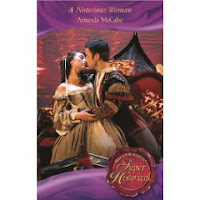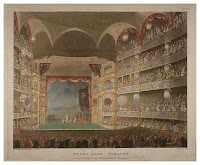 The Riskies are happy to welcome to the blog for the first time Celeste Bradley! Leave a comment for the chance to win a copy of Rogue in My Arms…
The Riskies are happy to welcome to the blog for the first time Celeste Bradley! Leave a comment for the chance to win a copy of Rogue in My Arms…
“There’s passion, adventure, non-stop action, and secrets that make the pages fly by” –RT Book Reviews
Celeste: Hi Risky Regencies! So nice to be here!
Riskies: Welcome! Tell us about Rogue in My Arms and the whole “Runaway Brides” series…
Celeste: This has been so much fun to write! All daddies, all the time. The Runaway Brides trilogy had the working title of “Three Lords and a Baby.” One day a tiny girl, Melody, is dropped off on the steps of Brown’s Club for Distinguished Gentlemen with nothing but a note claiming that her father is a member of the club. Since most of the club’s members are long past the sowing of their oats, the finger seems to point to the youngest three members, Lord Aidan de Quincy, Sir Colin Lambert, and Lord Jack Redgrave.
 In the first novel, Devil in My Bed, Aidan forces himself to face his past and find the woman who broke his heart more than three years past. Madeleine Chandler is running from her own past so fast that she runs right back into Aidan’s arms, at least long enough to get his help in leaving the country. One small lie about having Aidan’s baby doesn’t seem too high a price to pay for temporary sanctuary, until the love she thought was lost returns tenfold. Now with so much more to lose, how can Madeleine confess the truth?
In the first novel, Devil in My Bed, Aidan forces himself to face his past and find the woman who broke his heart more than three years past. Madeleine Chandler is running from her own past so fast that she runs right back into Aidan’s arms, at least long enough to get his help in leaving the country. One small lie about having Aidan’s baby doesn’t seem too high a price to pay for temporary sanctuary, until the love she thought was lost returns tenfold. Now with so much more to lose, how can Madeleine confess the truth?
In the second book, Rogue in My Arms, Sir Colin Lambert is searching for the stunning actress Chantal, who rejected him so soundly that he has never looked at another woman since. If he can offer her his new title and wealth, and make their child legitimate, surely she will wed him now? But Chantal has disappeared and Colin must hire saucy theater seamstress Prudence Filby to help him in his search. However, plain and common Pru is really a lady in hiding, protecting her young brother from greedy relations who would steal the inheritance he will receive when he comes of age. Now out of work and broke because Chantal fled town without paying her, Pru and her brother join the search for the flighty actress.
The journey takes them from London to Brighton to Bath, a mad race to catch up with Chantal before she weds another. On the way they encounter scoundrels, players and bandits, along with a string of other lovelorn men hell-bent to find Chantal! When Pru realizes that Colin is a man she could truly love, she can’t bear that he still adores the selfish Chantal. When Colin realizes that Pru is so much more than he first believed, he realizes that he must make a choice. Wed the woman he loves and doom his child to permanent illegitimacy, or try to make a family with the mother of his child?
 Rogue in My Arms will be released March 30th! And the third novel, Scoundrel in My Dreams is in progress at the moment. It will tell the poignant story of Lord John “Jack” Redgrave and his journey back from the trauma of war and the discovery of a love he never knew waited for him at home. It will be released in Fall 2010…
Rogue in My Arms will be released March 30th! And the third novel, Scoundrel in My Dreams is in progress at the moment. It will tell the poignant story of Lord John “Jack” Redgrave and his journey back from the trauma of war and the discovery of a love he never knew waited for him at home. It will be released in Fall 2010…
Riskies: And what was the inspiration behind this series?
Celeste: I was pondering fatherhood, actually! What makes a man a father? Is it blood? Is it simply a protective instinct? Motherhood is simple and biological–we must love our children. What if any man could learn to be a father, whether the child was his or not? These three men each suspect that Melody is theirs. Yet when they eventually learn the truth, should that change the love that has grown in them? Can letting one little girl into a man’s heart expand it enough to heal old wounds and allow him to love again?
Riskies: Did you come across any interesting or surprising research for these stories?
Celeste: Always! I loved learning about Bath, England. So much fascinating history, dating from Roman times. The story didn’t lend itself to including all the great facts I discovered. I had to be careful it didn’t become “Colin and Pru Go To Bath” because it really could have! I’m going to have to set an entire novel there someday.
 In Devil in My Bed I think I enjoyed learning about dumbwaiters the most. I found a lot of 1800 news articles about tragic accidents involving people climbing into dumbwaiters. They would try to use them to get into locked rooms, or to spy on their neighbors, or to escape a bill-collector at the apartment door. Doesn’t that inspire a string of stories in your head??
In Devil in My Bed I think I enjoyed learning about dumbwaiters the most. I found a lot of 1800 news articles about tragic accidents involving people climbing into dumbwaiters. They would try to use them to get into locked rooms, or to spy on their neighbors, or to escape a bill-collector at the apartment door. Doesn’t that inspire a string of stories in your head??
Riskies: What’s “risky” about this book?
Celeste: Well, I always take risks. I’m notorious for being far-fetched and “history-lite.” I love the Regency era but I can’t resist playing with the facts. I once wrote a book about the Prince Regent clambering through the storm drains with my hero and heroines, but since he would have been close to 80 at the time, I blithely snipped 20 years off his age and went for it. In Rogue, I think the riskiest thing I did was to dispense with a lot of overwrought conflict about class distinctions. As accurate as that might have been to the time, it would have made my characters seems shallow to a modern reader. Besides, money and rank cancels a lot of social errors, even now!
And my love scenes are pretty risky! Of course I have included, as always, my most beloved moment–a bathing scene!–and my favorite device–kidnapping! A Regency novel without a kidnapping is like Star Trek without the Enterprise.
Riskies: LOL! And what’s coming up next for you?
Celeste: I’m very excited about the release of Rogue in a couple of weeks, of course! I’m currently finishing up the third novel, Scoundrel in My Dreams, for publication this fall. I’ll be at the Romantic Times Convention in Columbus in April, and at RomCon in Denver in July. Details are here at my website.
And as I write this I’m on a plane to New York to meet with my agent and publisher about something really new and exciting! Something I can’t tell anyone about yet! It’s killing me to keep quiet, but updates will be on my website very soon.
I’d also like to add a note about my favorite cause, which is Literacy. I believe that most of the evils of the world could be cured with education and the empowerment and tolerance that comes with being well-read. This is a women’s issue as well, since two-thirds of the world’s under-educated are women. A clearinghouse of literacy projects exists at ProLiteracy.org. If you’d like more information, visit this website and join the effort to prevent ignorance and intolerance worldwide!
 (Warning: this is going to be a post that depends a lot on you, because I am interested to see what everyone thinks!) Often when I’m wasting my time, er, doing valuable research online I love to read blogs about fashion, beauty products, opera and ballet, jazz, all sorts of things, and I especially love blogs about movies. (Even though this means my Netflix account is totally out of control because of it). One of my favorite movie blogs is the Self Styled Siren, a wonderfully witty and intelligent look at classic movies. She recently had a fascinating post called “Unearthing the Uncool”.
(Warning: this is going to be a post that depends a lot on you, because I am interested to see what everyone thinks!) Often when I’m wasting my time, er, doing valuable research online I love to read blogs about fashion, beauty products, opera and ballet, jazz, all sorts of things, and I especially love blogs about movies. (Even though this means my Netflix account is totally out of control because of it). One of my favorite movie blogs is the Self Styled Siren, a wonderfully witty and intelligent look at classic movies. She recently had a fascinating post called “Unearthing the Uncool”. Traditional Regencies certainly used to be “uncool,” considered by some to be dry books for stereotypical grannies (I had someone tell me once I couldn’t possibly write them, I looked too young! Which was flattering, of course, but kinda made me want to get all lecture-y on them about the intelligence and variety of trads. Ditto for a friend of my mine who ONE TIME read a Regency, didn’t like it–even though she couldn’t remember the title–and decided they were all like that one). But now that they’re obscure and out-of-print and all that, maybe they’re like some little indie band out of Austin. And on some book blogs there are often threads like “books you like that no one else has read” or “books everyone liked that you hated,” which I guess can be sort of like cool/uncool. Mostly, though, romance genres seem to be pretty much anything goes. If I don’t like something, someone else will, and vice versa, and I like it that way. The variety is what makes it fun.
Traditional Regencies certainly used to be “uncool,” considered by some to be dry books for stereotypical grannies (I had someone tell me once I couldn’t possibly write them, I looked too young! Which was flattering, of course, but kinda made me want to get all lecture-y on them about the intelligence and variety of trads. Ditto for a friend of my mine who ONE TIME read a Regency, didn’t like it–even though she couldn’t remember the title–and decided they were all like that one). But now that they’re obscure and out-of-print and all that, maybe they’re like some little indie band out of Austin. And on some book blogs there are often threads like “books you like that no one else has read” or “books everyone liked that you hated,” which I guess can be sort of like cool/uncool. Mostly, though, romance genres seem to be pretty much anything goes. If I don’t like something, someone else will, and vice versa, and I like it that way. The variety is what makes it fun.









